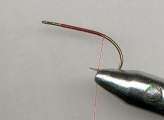 1: Start this fly by placing your hook into the vise, making sure it is secured tightly. Start the thread behind the hook eye and wrap a thin smooth base of thread back towards the hook bend. Keep wrapping the thread until you reach the point above the barb.
1: Start this fly by placing your hook into the vise, making sure it is secured tightly. Start the thread behind the hook eye and wrap a thin smooth base of thread back towards the hook bend. Keep wrapping the thread until you reach the point above the barb.
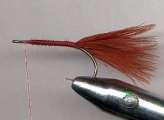 2: From your strung marabou choose a single marabou feather that has a full and thick tip section. Bring your thread back to the front of the hook and measure the feather so that when tied in the tail will be the same length as the hook shank. After you have found the right length for the tail, tie it down on top of the hook shank. Now wrap the thread down to the point above the barb and back up the hook shank ending just behind the hook eye.
2: From your strung marabou choose a single marabou feather that has a full and thick tip section. Bring your thread back to the front of the hook and measure the feather so that when tied in the tail will be the same length as the hook shank. After you have found the right length for the tail, tie it down on top of the hook shank. Now wrap the thread down to the point above the barb and back up the hook shank ending just behind the hook eye.
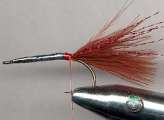 3: Select 5-7 fibers from a package of red krystal flash and tie them in behind the hook eye. Again wrap the thread down to the point above securing the flash in place. Trim the ends of the flash so that they are equal to the tail you made from the red marabou. Now that the tail section is done cut a strip of silver flat tinsel and tie it in at the point above the hook barb. Wrap the tinsel up the hook shank and back down to the tail section creating a smooth body that has with no gaps between the tinsel.
3: Select 5-7 fibers from a package of red krystal flash and tie them in behind the hook eye. Again wrap the thread down to the point above securing the flash in place. Trim the ends of the flash so that they are equal to the tail you made from the red marabou. Now that the tail section is done cut a strip of silver flat tinsel and tie it in at the point above the hook barb. Wrap the tinsel up the hook shank and back down to the tail section creating a smooth body that has with no gaps between the tinsel.
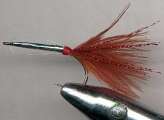 4: From some thirty-pound monofilament fishing line cut a section about 6 inches long. Take this section and pull it through the hook eye and stretch it evenly down the top and bottom of the hook shank. Using your thread, tie off the monofilament so that it is snugly attached to the top and bottom of the hook shank. Once the mono is tied off whip finish the thread and adjust the mono which is still in place on top and the bottom of hook, to the shape you want for your minnow (make it fatter or skinner). Trim the ends of the mono when you have the shape just right and cement the tie off point.
4: From some thirty-pound monofilament fishing line cut a section about 6 inches long. Take this section and pull it through the hook eye and stretch it evenly down the top and bottom of the hook shank. Using your thread, tie off the monofilament so that it is snugly attached to the top and bottom of the hook shank. Once the mono is tied off whip finish the thread and adjust the mono which is still in place on top and the bottom of hook, to the shape you want for your minnow (make it fatter or skinner). Trim the ends of the mono when you have the shape just right and cement the tie off point.
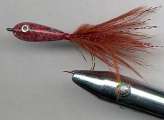 5: Take the completed fly down to where you will be applying the epoxy. Get your 5-minute epoxy, red sparkles and epoxy drier ready. Before I start I like to turn my drier on and have it turning, I suggest you do the same. Now, mix equal amounts of the epoxy and add about ½ a teaspoon of red sparkles till you have a nice red mix. It will be hard to tell when the epoxy mix has cleared but give it a little time. Apply the epoxy to the fly, starting at the rear and working towards the front (the fly should be tilted on its side). Only add epoxy to one side of the minnow, because it will slowly leech through to the other side by itself. Using your bodkin, run up and down the underside of the fly to help pull the epoxy through. Once the epoxy is covering both sides of the fly, take a quick check to see that all parts are thoroughly covered with the epoxy mix.
5: Take the completed fly down to where you will be applying the epoxy. Get your 5-minute epoxy, red sparkles and epoxy drier ready. Before I start I like to turn my drier on and have it turning, I suggest you do the same. Now, mix equal amounts of the epoxy and add about ½ a teaspoon of red sparkles till you have a nice red mix. It will be hard to tell when the epoxy mix has cleared but give it a little time. Apply the epoxy to the fly, starting at the rear and working towards the front (the fly should be tilted on its side). Only add epoxy to one side of the minnow, because it will slowly leech through to the other side by itself. Using your bodkin, run up and down the underside of the fly to help pull the epoxy through. Once the epoxy is covering both sides of the fly, take a quick check to see that all parts are thoroughly covered with the epoxy mix.
6: Place the fly onto your drier and watch to see if the epoxy is being smoothed out to your liking. If the epoxy is not reaching all the way to the tail or clumping up into a big mess simply remove the fly and manipulate by hand. Turning the fly by hand will allow you to precisely adjust the epoxy the way you want it; then place back on the drier to finish curing. After the fly has completely hardened, I like to leave them over night; I mix a second small batch of epoxy. From this epoxy I place small amounts on the head of the fly where the eyes will eventually be placed. I then place the holographic eyes into the epoxy and let them dry for a few minutes. After the eyes are permanently glued, I coat the whole minnow body with head cement. This coating is not necessary, but I find it gives a crystal clear look to the epoxy and fills in any little holes that might be present. When tying this fly pattern I suggest tying a dozen or so flies at one time, and then applying epoxy to them all at once. This way you will not waste as much epoxy between steps and really get the hang of how to handle the epoxy.
Tight lines and smooth threads.
author website: visit | author bio
![]()
Pages: 1 2

